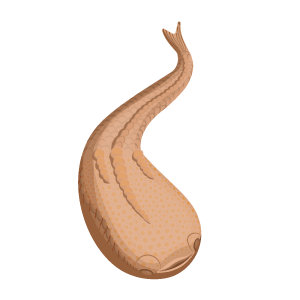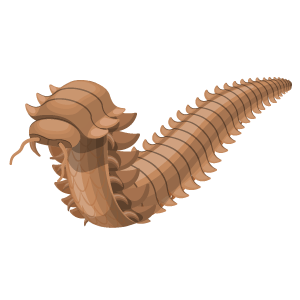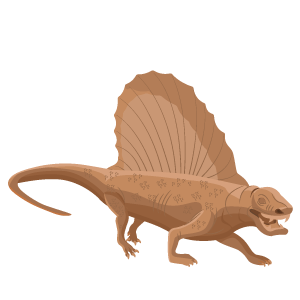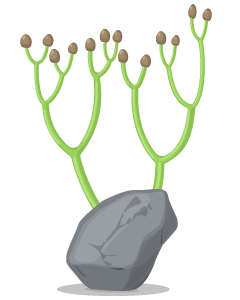5.7 Paleozoic时代
章节大纲
-
What you will learn
::你会学到什么-
What were the major events in the periods of the Paleozoic Era
::Paleozoic时代的重大事件是什么? -
Diversification of plant and
life during the Paleozoic Era
::Paleozoic时代的植物和生活多样化
What was early life like?
::早期生活是怎样的?Prehistoric underwater life exploded with amazing new creatures during the Paleozoic Era. Evolution allowed life to take many diverse forms, eventually developing the necessary adaptations to move from the ocean onto land.
::在Paleozoic时代,史前水下生物与惊人的新生物一起爆炸。 进化允许生命以多种形式出现,最终发展出必要的适应,从海洋向陆地移动。Life During the Paleozoic
::Paleozoic期间的生活The Paleozoic Era is literally the era of “old life.” It lasted from 541 to 252 million years ago and is divided into six periods (see the Figure ). The era began with a spectacular burst of new life. This is called the Cambrian explosion . The era ended with the biggest the world had ever seen. This is known as the Permian extinction .
::Paleozoic Eraa(Paleozoic Eraa)实际上是“老生常谈”的时代。 它从54.1亿年前的5.51亿年持续到2.52亿年,并分为六个时期(见图 ) 。 时代从新生命的惊人爆发开始。 这就是所谓的Cambrian爆炸。 这个时代以世界史无前例的最大的爆炸结束。 这被称为Permian灭绝。-
Anomalocaris was a large carnivorous arthropod from the Cambrian Period (541–485 million years ago)
::Anomolocaris是坎布里安时期的大型食肉类节肢动物(541万至4.85亿年前)。 -
The first vertebrates, such as Astraspis, evolved during the Ordovician Period (485–444 million years ago)
::第一个脊椎动物,如阿斯特拉斯派斯,在奥尔多维奇时期(4.85至4.44亿年前)演变而来。 -
Osteostracans were jawless fishes with bony armor that lived on the seafloor during Silurian Period (444–419 million years ago)
:四亿四千四百万至四亿九百万年前)
-
Giant arthropods, such as the 2.6 meter millipede Arthropleura, lived on land during the Carboniferous Period (359–299 million years ago)
::巨型节肢动物,如2.6米毫升的阿瑟罗普勒拉,在碳纤维时期(359至299亿年前)生活在陆地上。 -
Placoderms were a group of armored jawed fishes that lived during the Devonian Period (419–359 million years ago)
::等离子体是一群在德文时期(419至3.59亿年前)生活的有装甲的下巴鱼。 -
Land vertebrates, such as Dimetrodon, were common by the Permian Period (299–252 million years ago)
::波尔米亚时期(2.99亿至2.52亿年前)常见地脊椎动物,如迪米特罗登(Dimetrodon)
The Paleozoic Era
::Paleozoic时代The Cambrian Period : The Paleozoic era began with the appearance of many new kinds of organisms in the Cambrian Period (541–485 million years ago). All of the major animal phyla appeared during this period. Small ocean invertebrates called trilobites became abundant
::坎布里安时期:帕利奥佐科时代始于坎布里安时期(541至4.85亿年前的541至4.85亿年前)许多新型生物的出现。 在此期间,出现了所有主要的动物植物。 被称为三环的小型海洋无脊椎动物变得丰富。Cambrian explosion: Early arthropods known as trilobites were abundant during the Cambrian and later became extinct; however, the phyla they represent persist to this day.
::Cambrian爆炸:在Cambrian期间,被称为三叶虫的早期节肢动物大量繁殖,后来灭绝;然而,它们所代表的植物素一直持续到今天。The Ordovician Period : During the next period, the Ordovician Period (505–440 million years ago), the oceans became filled with invertebrates of many types. Also during this period, the first evolved and plants colonized the land for the first time. But animals still remained in the .
::奥尔多维奇时期:在下一个时期,奥多维奇时期(50.5亿到4亿4千万年前 ) , 海洋中充斥着多种种类的无脊椎动物。 在此期间,第一个进化的植物和植物首次将这片土地殖民化。 但动物仍然留在这块土地上。The Silurian Period : During the Silurian Period (440–410 million years ago), corals appeared in the oceans, and fish continued to evolve. On land, appeared. With special tissues to circulate water and other materials, these plants could grow larger than the earlier .
::锡卢尔时期:在锡卢尔时期(440 - 410亿年前 ) , 珊瑚出现在海洋中,鱼类也在不断进化。 在陆地上,鱼也在不断进化。 有了特殊组织来循环水和其他物质,这些植物的生长量可能比早期还要大。Cooksonia, a branching vascular plant with sporangia at the tips of each branch. Cooksonia fossils measure just centimeters in height and date from the Silurian period. The Devonian Period : During the Devonian Period (410–360 million years ago), the first seed plants evolved. Seeds have a protective coat and stored food to help these plants survive. Seed plants eventually became the most common type of land plants. In the oceans, fish with lobe fins evolved. They could breathe air when they raised their heads above water. would be necessary for animals to eventually colonize the land.
::德文时期:在德文时期(410-3.6亿年前),第一批种子植物进化了。种子有防护服,储存食物以帮助这些植物生存。 种子植物最终成为最常见的陆地植物类型。 在海洋中,带叶鳍的鱼类进化了。 当它们把头抬高到水面上时,它们可以呼吸空气。 动物最终将这片土地殖民化是必要的。On land, club mosses, horsetails, and ferns joined primitive seed plants and early trees to form the first forests. The Carboniferous Period : Next, during the Carboniferous Period (359-299 million years ago), widespread forests of huge plants left massive deposits of carbon that eventually turned to coal. The first evolved to move out of the water and colonize land, but they had to return to the water to reproduce. Soon after amphibians arose, the first evolved. They were the first vertebrates that could reproduce on dry land.
::碳纤维时代:接下来,在碳纤维时代(359—299亿年前的359—299亿年),大片大片植物的森林留下了大量的碳矿,最终变成了煤炭。 第一次从水中移出,殖民土地,但是它们不得不回到水中繁殖。两栖动物出现后不久,第一次就进化了。它们是第一个可以在干旱土地上繁殖的脊椎动物。The Permian Period : During the Permian Period (299–252 million years ago), all the major land masses collided to form a supercontinent called Pangaea . Temperatures were extreme, and the climate was dry. Plants and animals evolved adaptations to dryness, such as waxy leaves or leathery skin to prevent water loss. The Permian Period ended with a mass extinction.
::伯尔米亚时期:在伯尔米亚时期(2.99亿到2.52亿年前 ) , 所有主要陆地大块都相撞形成一个叫做潘加亚的超级大陆。 温度非常高,气候也十分干燥。 植物和动物演变成干燥的适应性,比如蜡叶或皮革等,以防止水流失。 伯尔米亚时期以大规模灭绝结束。The supercontinent Pangaea encompassed all of today’s continents in a single land mass. This configuration limited shallow coastal areas which harbor marine species, and may have contributed to the dramatic event which ended the Permian - the most massive extinction ever recorded. In the mass extinction that ended the Permian, the majority of went extinct. Many hypotheses have been offered to explain why this mass extinction occurred, but most sceintists believe that a series of enormous volcanic eruptions relased carbon dioxide and other greenhouse gases into the atmosphere . This led to intense , as well as changes in the chemistry of the ocean. Acidic conditions and low oxygen levels in the ocean could have driven many organisms to extinction .
::在结束Permian的大规模灭绝中,大部分人灭绝了。许多假设都是为了解释为什么大规模灭绝的原因,但大多数探险家认为,一系列巨大的火山爆发将二氧化碳和其他温室气体重新排放到大气中。 这导致了海洋化学的剧烈变化。 海洋中的酸性条件和低氧水平可能使许多生物灭绝。Despite the great loss of life, there was light at the end of the tunnel. The Permian extinction paved the way for another burst of new life at the start of the following . This included the evolution of the dinosaurs .
::尽管生命遭受巨大损失,但隧道的尽头还是一片光明。波尔米亚的灭绝为在下面开始的新生命又一爆发铺平了道路。这包括恐龙的进化。
Summary
::摘要-
The Paleozoic Era began with the Cambrian explosion. It ended with the Permian extinction.
::帕利奥索伊时代以坎布里安爆炸开始,以波尔米亚灭绝而结束。 -
During the era, invertebrate animals diversified in the oceans. Plants, amphibians, and reptiles also moved to the land.
::在这个时代,无脊椎动物在海洋中多样化,植物、两栖动物和爬行动物也迁移到陆地。
Review
::回顾-
What was the Cambrian explosion?
::什么是坎布里安爆炸? -
What was the Permian extinction?
::波尔米亚的灭绝是什么? -
List important evolutionary events that occurred during the Cambrian Period.
::列出在坎布里安时期发生的重要的进化事件。 -
List important evolutionary events that occurred during the Ordovician Period.
::列举了奥尔多维奇时期发生的重要的演进事件。 -
List important evolutionary events that occurred during the Carboniferous Period.
::列出在碳纤维时代发生的重要的进化事件。 -
Describe Pangaea. When did Pangaea form?
::描述潘加亚 潘加亚是什么时候形成的?
-
What were the major events in the periods of the Paleozoic Era










